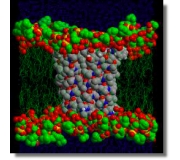FIVEPHOTON FLUORESCENT MEMBRANE POTENTIAL ASSAY KIT - High Throughput Format (Part. No. mpHTS-Kit)
 Click to enlarge |
|
|
Fluorescent Voltage-Sensitive Dye Membrane Potential Assay Kits
Lead time Approx 1 week.
Highlights of the Membrane Potential Assay System:
View pull-down menu above to select option.
Kits with pre-validated dye-quencher mix
Bulk Pharmacological Screen Format
* Part mpHTS-KitB; dye-quencher mix suitable for 8 plates per vial.

Figure legend. Dose response curves to standard sodium channel blockers in transfected CHO cells measured by a fluorescent plate reader. CHO cells were over expressing TTX sensitive NaV channel subunit. Veratridine at its EC80 (i.g. 100uM) was added to open NaV channels. NaV channel blockers that were applied include: Amitriptyline, Dibucaine, Tetracaine, Tetrodotoxin (TTX).
Introduction to Ion Channel Membrane Potential Assay Dyes
The bilipid membrane of a cell typically has a transmembrane potential of approximately –60 to -80 mV (negative inside) as a consequence of mostly Na+, K+, and Cl- ion concentrations gradients which are maintained by active ion transporters. Voltage sensitive probes (VSP) offer a convenient method of detecting the translocation of these ions across cellular membranes. The thiobarbituric and bis-barbituric acid oxonols, referred to as DiSBAC2 and DiBAC3 dyes respectively, are VSPs with distinct excitation and emission parameters. The FIVEphoton Biochemicals membrane potential assay kits utilize a dye formulation which is very similar to the most popular oxonol dyes for transmembrane potential measurement. Membrane potential dyes enter depolarized cells and associate with intracellular proteins or membranes, causing enhanced fluorescence and a spectral shift to red wavelengths. Increase in membrane depolarization leads to further influx of dye and thus an increase in fluorescence that can be measured by fluorescence spectroscopy and fluorescent plate readers.
The membrane potential assay dyes can be used to measure transmembrane potential in living cells as a stand alone reagent or in combination with other fluorescent indicators. The dye systems are recommended for use in fluorescent plate readers, fluorometers, and flow cytometers.
Related Kits and Supplements
I. Research level membrane potential assay kits. Provides smaller amounts of dye and quencher compared to the high throughput kit.
II. Dye and external physiological buffer supplements
Product References
Eurkayotes
1. Purnell, Marcy C., and Terence J. Skrinjar. "Bioelectric Field Enhancement: The Influence on Membrane Potential and Cell Migration In Vitro." Advances in Wound Care 5.12 (2016): 539-545. Link to article
2. Igor M Pongrac, Ivan Pavičić, Mirta Milić, Lada Brkić Ahmed, Michal Babič, Daniel Horák, Ivana Vinković Vrček, Srećko Gajović. 2016. Oxidative stress response in neural stem cells exposed to different superparamagnetic iron oxide nanoparticles. International Journal of Nanomedicine. Volume 2016:11 Pages 1701—1715. Link to article
3. Binepal, G., Gill, K., Crowley, P., Cordova, M., Brady, L. J., Senadheera, D. B., & Cvitkovitch, D. G. (2016). The Trk2 potassium transport system in Streptococcus mutans and its role in potassium homeostasis, biofilm formation and stress tolerance. Journal of Bacteriology, JB-00813. Link to article
Bacteria
1. Singh, Kamna, et al. "The copYAZ operon functions in copper efflux, biofilm formation, genetic transformation, and stress tolerance in Streptococcus mutans." Journal of bacteriology 197.15 (2015): 2545-2557. Link to article
Representative References On Ion Channel Membrane Potential Assays
Storage and Handling: Shipped at ambient temperature. Store at -20oC for Option A long term.
kw. fluorescent membrane potential dye, membrane, ion channel, voltage sensitive dye, ion channel assay kit, voltage sensitive probe, TRP, ligand-gated ion channel, CFTR, sodium channel, Na channel, K+ channel, Cl- channel, transporter, ABC transporter
|
 Products
Products Manuals
Manuals



